
Asdrubale Mattei (died 1638), Duca di Giove, was an Italian nobleman of the House of Mattei, an avid art collector and a patron of Caravaggio.

Asdrubale Mattei (died 1638), Duca di Giove, was an Italian nobleman of the House of Mattei, an avid art collector and a patron of Caravaggio.
Mattei was the third of three sons of Alessandro Mattei and Emilia Mazzatosta and the younger brother of Ciriaco Mattei and Cardinal Girolamo Mattei. He married Costanza Gonzaga (of the House of Gonzaga) and they had three sons:
In 1597, Mattei and his brother Ciriaco paid 65,000 scudi for the fortified comune of Giove [2] which allowed Mattei to be appointed Duca di Giove (Duke of Giove). Mattei passed the title and property to his son, Girolamo. Between 1598 and 1618, Mattei commissioned architect Carlo Maderno to build the Palazzo Mattei. [3]
Mattei was a strong supporter of baroque artist Caravaggio. The artist lived at Mattei residences, the Palazzo Mattei and latter the Villa Mattei and Mattei (and his brother Ciriaco) commissioned a large number of works from the painter. The works included The Taking of Christ (for which Mattei and his brother paid a paltry 125 scudi [2] ).
It was reported that Mattei began a tradition which later took hold among Italian noblemen and carried on through the 17th century. Upon meeting his social "superior", Cardinal Alessandro Farnese (both were in carriages) in a public street, Mattei ordered his carriage stopped as a mark of respect.[ citation needed ] The cardinal then ordered his carriage to come alongside Mattei's so that the two could converse. The practice became a standard part of interactions between the various sub-classes of Italian nobility. [4]

Michelangelo Merisi da Caravaggio, known mononymously as Caravaggio, was an Italian painter active in Rome for most of his artistic life. During the final four years of his life, he moved between Naples, Malta, and Sicily until his death. His paintings have been characterized by art critics as combining a realistic observation of the human state, both physical and emotional, with a dramatic use of lighting, which had a formative influence on Baroque painting.

The Taking of Christ is a painting, of the arrest of Jesus, by the Italian Baroque master Michelangelo Merisi da Caravaggio. Originally commissioned by the Roman nobleman Ciriaco Mattei in 1602, it is housed in the National Gallery of Ireland, Dublin.

The Denial of Saint Peter(La Negazione di Pietro) is a painting finished around 1610 by the Italian painter Caravaggio. It depicts Peter denying Jesus after Jesus was arrested. The painting is housed in the Metropolitan Museum of Art in New York City.
John the Baptist was the subject of at least eight paintings by the Italian Baroque artist Michelangelo Merisi da Caravaggio (1571–1610).

The Supper at Emmaus is a painting by the Italian Baroque master Caravaggio, executed in 1601, and now in London. It depicts the Gospel story of the resurrected Jesus's appearance in Emmaus.
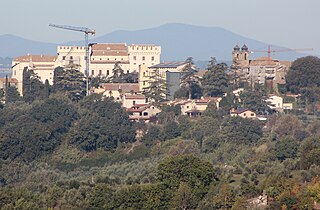
Giove is a comune in the province of Terni.
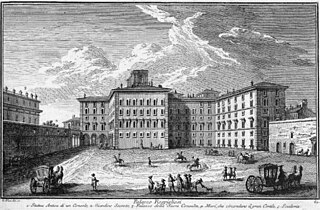
The Palazzo Pallavicini-Rospigliosi is a palace in Rome, Italy. It was built by the Borghese family on the Quirinal Hill; its footprint occupies the site where the ruins of the baths of Constantine stood, whose remains still are part of the basement of the main building, the Casino dell'Aurora. Its first inhabitant was the famed art collector Cardinal Scipione Borghese, the nephew of Pope Paul V, who wanted to be housed near the large papal Palazzo Quirinale. The palace and garden of the Pallavicini-Rospigliosi were the product of the accumulated sites and were designed by Giovanni Vasanzio and Carlo Maderno in 1611–16. Scipione owned this site for less than a decade, 1610–16, and commissioned the construction and decoration of the casino and pergolata, facing the garden of Montecavallo. The Roman palace of this name should not be mistaken for the panoramic Villa Pallavicino on the shores of Lake Como in Lombardy. The Palace has also been the scene of important cultural and religious events. On June 6, 1977 Princess Elvina Pallavicini invited in Palazzo Pallavicini Rospigliosi the archbishop monsignor Marcel Lefebvre for a conference on the Second Vatican Council and for the celebration of a Traditiona Mass, under the careful direction of the marquis Roberto Malvezzi, and Frigate Captain marquis Luigi Coda Nunziante di San Ferdinando. Many members of Alleanza Cattolica, the baron Roberto de Mattei, the pharmacologist Giulio Soldani, the sociologist Massimo Introvigne, the psychiatrist Mario Di Fiorino and Attilio Tamburrini and his brother Renato Tamburrini took part to the event.
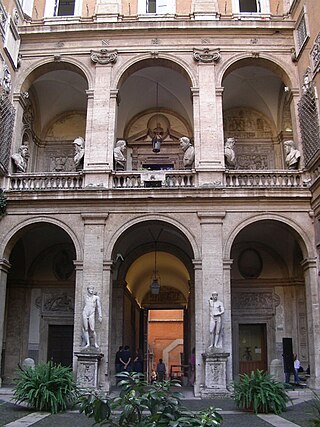
The Palazzo Mattei di Giove is the most prominent among a group of Mattei houses that forms the insula Mattei in Rome, Italy, a block of buildings of many epochs.

The House of Mattei was one of the most powerful noble families of Rome during the Middle Ages and early modern era, holding high positions in the papal curia and government office. The family amassed significant art collections under art enthusiasts such as Ciriaco Mattei.
Pier Francesco Orsini, also called Vicino Orsini, was an Italian condottiero, patron of the arts, and duke of Bomarzo. He is famous as the commissioner of the Mannerist Park of the Monsters in Bomarzo.
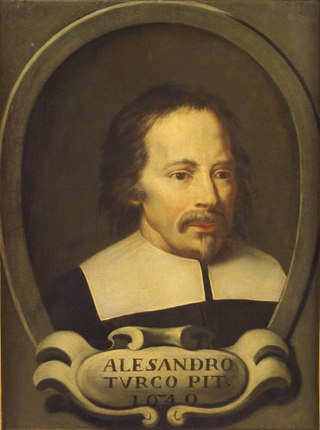
Alessandro Turchi was an Italian painter of the early Baroque, born and active mainly in Verona, and moving late in life to Rome. He also went by the name Alessandro Veronese or the nickname L'Orbetto. His style has been described as soft and Caravaggesque at the same time.
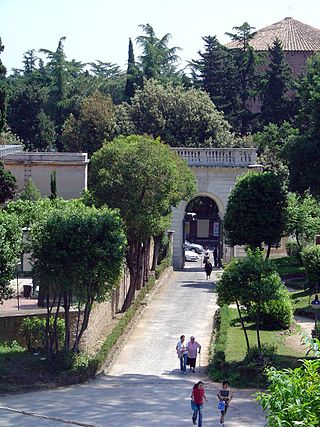
The Villa Celimontana is a villa on the Caelian Hill in Rome, best known for its gardens. Its grounds cover most of the valley between the Aventine Hill and the Caelian.
Ciriaco Mattei was an Italian nobleman of Rome and of the House of Mattei and one of the most prolific art collectors of his time.
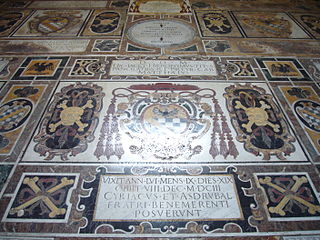
Girolamo Mattei was an Italian Cardinal from the House of Mattei.

The Fontana delle Tartarughe is a fountain of the late Italian Renaissance, located in Piazza Mattei, in the Sant'Angelo district of Rome, Italy. It was built between 1580 and 1588 by the architect Giacomo della Porta and the sculptor Taddeo Landini. The bronze turtles around the upper basin, usually attributed either to Gian Lorenzo Bernini or Andrea Sacchi, were added in either 1658 or 1659 when the fountain was restored.

Fabrizio Spada was an Italian Cardinal of the Roman Catholic Church, and served as Secretary of State under Pope Innocent XII.

Luigi Mattei was an Italian military General and Marquis de Belmonte. During the 17th century he commanded troops loyal to the papal armies of Barberini Pope Urban VIII and Pamphili Pope Innocent X during the Wars of Castro.
Girolamo Mattei was an Italian nobleman of the House of Mattei and Duke of Giove.
Mattei is a surname. Notable people with the surname include:
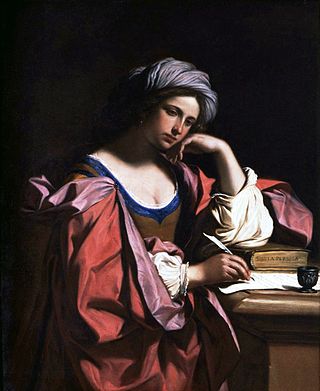
The Persian Sibyl is a 1647 oil on canvas painting of the Persian Sibyl by Guercino, now in the Musei Capitolini in Rome.